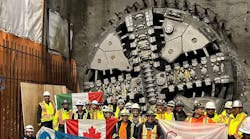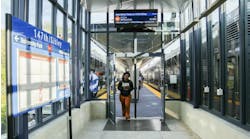Phyllis TBM on Broadway Subway project breaks through at Broadway-City Hall Station
The second of two massive tunnel-boring machines (TBM) that are excavating twin tunnels for the government of British Columbia’s Broadway Subway Project broke through to the future Broadway-City Hall Station, marking another milestone for the major rapid-transit project.
The TBM is named for Phyllis Munday, a passionate mountaineer best known for exploring and documenting the coast mountains and Mount Waddington and nurse and founder of the Girl Guides in British Columbia. Phyllis has excavated 1,350 meters (0.83 miles) of tunnel and installed 884 liner rings since starting at the future Great Northern Way-Emily Carr Station in late November 2022.
The Broadway Subway Project is a 5.7-kilometer (3.5-mile) extension of the Millennium Line from VCC-Clark Station to West Broadway and Arbutus Street, which will provide people with fast, convenient SkyTrain service along the Broadway corridor. The corridor is home to British Columbia’s second-largest jobs center, health-care services, an emerging innovation and research hub and growing residential communities.
The project means faster travel, better access and fewer cars on the road in the heavily used corridor. Once in service, the trip from VCC-Clark to Arbutus Station will take 11 minutes, saving the average transit commuter almost 30 minutes a day and relieving congestion along Broadway.
Phyllis has joined Elsie, the tunnel-boring machine named after notable British Columbia-born Elizabeth (Elsie) MacGill, the world’s first female aeronautical engineer, at the future Broadway-City Hall Station for planned maintenance.
The new Broadway-City Hall Station is the deepest station along Broadway at more than 20 meters (0.01 miles) underground, so the Millennium Line extension can be built underneath the active Canada Line. The station stretches 210 meters (0.13 miles) over two blocks under Broadway between Alberta and Cambie streets to provide space for a crossover section of track where trains can switch directions when needed. The station will have additional capacity for the expected volume of transit users, including passenger connections being built underneath Cambie Street, for people to easily transfer between the north-south Canada Line and the east-west Millennium Line.
In May, at the Broadway-City Hall Station site, a pedestrian bridge was installed to reconnect the south sidewalk between Alberta and Yukon streets. It is one of several installed in the station blocks along Broadway that, combined with the traffic decks, keep people moving and preserve access to this transportation and retail corridor while work on the underground stations carries on below.
Progress continues to be made at the elevated guideway where crews are installing the deck on top of the completed girders that connect the 21 columns between VCC-Clark Station and the future Great Northern Way-Emily Carr Station. Construction is also ongoing at all six station locations with activities ranging from excavation, concrete pours, waterproofing, rebar installation and station wall construction.
The Broadway Subway Project will support new transit-oriented developments, creating efficient, integrated communities where people can rely on public transit to connect them to their work and social lives.
It is estimated the project will create more than 13,000 direct and indirect jobs during construction, supporting economic development within the region and beyond.


